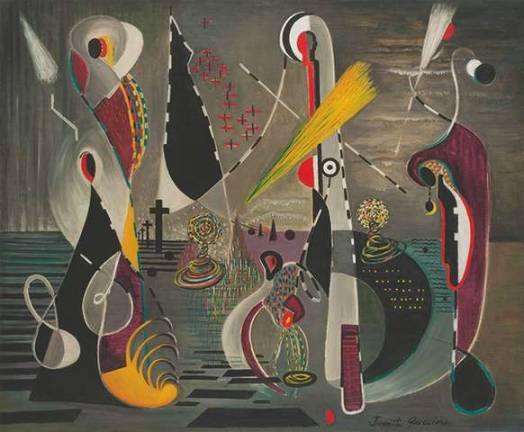'Juanita Guccione, Defiant Acts' exhibit at Seligmann Center

SUGAR LOAF — The Seligmann Center at the Citizens Foundation is pleased to announce “Juanita Guccione, Defiant Acts,” a new gallery exhibition featuring the art of the 20th century surrealist painter, Juanita Guccione. The exhibition opens Saturday, Sept. 13, and continues through Nov. 2.
On Sunday, Sept. 14, noted art historian Susan Aberth will present a lecture on the work of Guccione and the women artists of the surrealist movement, who are increasingly being rediscovered.
Guccione (1904-1999) is one such artist whose work — and life — mirrored the radically creative and philosophical underpinnings of Surrealism. After a childhood in Massachusetts and Brooklyn, Guccione became a fashion model in New York City in the 1920s. Rather than falling into the romantic role of ‘muse,’ she studied at the Art Students League before venturing to France, Italy and Greece, supporting herself through portrait commissions.
From there she sailed to Egypt, eventually settling in 1931 in Bou Saada, an artists’ colony in Algeria, among the Ouled Nail tribe. Travelling among Bedouin nomads in the Sahara, she produced a diverse oeuvre of portraits and landscapes that in 1935 would be exhibited at the Brooklyn Museum, alongside works by Jackson Pollock and Mark Rothko. After the birth of her son in 1934, Guccione returned to New York, designing murals with David Alfaro-Siqueiros for the WPA and studying for seven years with Hans Hofmann. Guccione infused social realism, cubism, surrealism and abstraction with her own indefinable and audacious style.
Women populate her canvases in wonderland environments, alongside animals, architecture, and fantastical landscapes, at times hinting to world events, other times mystic explorations.
The writer and poet Anais Nin said of Juanita, “Few people can paint the world of our dreams with as much magic, precision and clarity.”
The Seligmann Center was bequeathed to the Orange County Citizens Foundation by Arlette Seligmann, the widow of the Surrealist Kurt Seligmann. Seligmann, who came to this country in 1939, was an active member of the artist-in-exile group in the 1940s and a longtime teacher at Brooklyn College. He and Arlette moved to this former dairy farm in the early 1940s, where he worked and they entertained many of their friends and colleagues, from Alexander Calder to Marcel Duchamp. The latter famously fired gun shots at the stone wall of a barn, later using an image of the wall with the bullet holes on the cover of the catalogue for Andre Breton's 1942 exhibition, First Papers of Surrealism.
The Center is located on 55 acres in Sugar Loaf and works to bring people together to create and share new ideas, artistic performances, and thought-provoking programming. For more information, visit occitizensfoundation.org or contact Nancy Proyect at 845-469-9459 or nancy@occitizensfoundation.org.
The Seligmann Center is located at 23 White Oak Drive, Sugar Loaf.